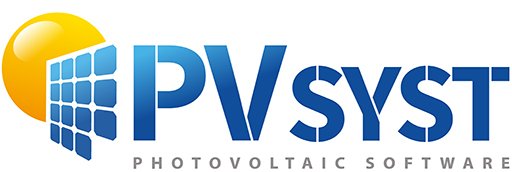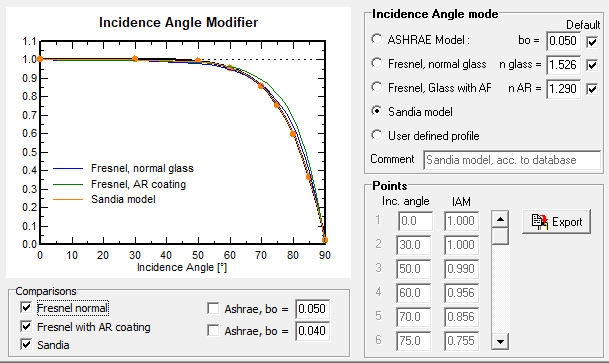-
Posts
2070 -
Joined
-
Last visited
Everything posted by André Mermoud
-

Calculating Voc - How is irradiation taken into account
André Mermoud replied to Andrew's topic in PV Components
In PVsyst the Voc(temp) is calculated by the one-diode model. The expression given here is a direct result of the "pure" one-diode model: you can easily get it by simply writing the one-diode model equation for I = 0 PVsyst adds some corrections to this "pure" model, so that the result may be slightly different. -

Can't do negative azis Azimuth on "Bifacial system" Input
André Mermoud replied to Tokoyoshi's topic in Problems / Bugs
Before defining the Bi-facial tool, please make sure that your system is really compatible with a tracking array, horizontal axis orientated at -9°: - In the orientation part "Horizontal axis, unlimited trackers", or: - In the orientation part "Tracking, tilted or horizontal axis", - And in the 3D part you have to define an array with Azimuth = 0 in the tracking parameters, and rotate this whole "rectangular" object by -9° in the scene. -
This information is now part of the project: in the project's definition dialog, button "Project's settings". The value in the hidden parameters is just an initialization for new projects.
-

Gap between real and theoretical Production
André Mermoud replied to aarab.boujemaa2018's topic in How-to
The agreement between the simulated data and measured ones highly depends on the meteo data. And as a second cause, on the parameters you have chosen for the simulation. They may also be due to an erroneous measurement. In good measurements and simulation conditions, the accuracy of the simulation is usually below some few percents. Please see the FAQ What is the accuracy of the simulation results ? -
You can simply save the whole workspace \PVsyst660_Data\. You will find its location in the main menu "Files > Workspace" dialog. NB: Remember that at each new installation (update), PVsyst automatically saves a full copy of your present workspace.
-
Please send the following files to support@pvsyst.com: - your original data CSV file, - the *.SIT file of the location of your data (that you are using for the import), in the directory \sit\ - the MEF file (formatting file) you have defined for this import, that you will find in the directory \Meteo\ - the MET file you have created.
-

Conversion of data yeilds different location
André Mermoud replied to DomB's topic in Problems / Bugs
When you open the dialog "Import ASCII Meteo files", in the first frame "Ascii Source file", make sure that you have correctly defined the site of your data. -

Calculation of azimuth angle after defining shading scene
André Mermoud replied to Mahesh's topic in Shadings and tracking
Yes, when you have a tilted base on your PV tables, the plane orientation changes (tilt and awimuth). See our FAQ With sheds on a tilted roof, PVsyst changes my orientation. -
In "Databases > Meteo Tables and graphs" tool, you can create a table in hourly values, and export this table as a CSV file (menu "Export") You can reupload this file using "Databases > Import ASCII meteo files".
-

Inverter efficiency problem with overpower
André Mermoud replied to charlesladd's topic in Problems / Bugs
This representation is quite correct. The efficiency is defined as the Pout / Pin ratio. Now if the Pout is limited to the PNom value, the efficiency Pout/Pin will obviously diminish above Pout, in the way shown on the graph. Now for the "unreasonable" Overpower loss: - Please remember that the value in the sizing tool is a rough pre-evaluation, just for helping you to design your system. The reliablel value is the result of the simulation. See the FAQ Why the overload loss is not the same at designe time as in the simulation ? - In some conditions (high array voltage), the overpower may significantly increase. See the FAQ Why sometimes the overload losses increase significantly ? -
These values are simply the plane tilt and plane azimuth of your tracker, at a given time. I don's see in which way they are erratic: these are calculated from the tracker's position (phi angle, axis tilt and azimuth, depending on the tracking mode) and are quite real angles.
-
I really don't understand how you got this result. The Sandia model is hard-coded in PVsyst, the values are unmodifiable and give a result very close to the normal Fresnel's model. This curve is probably a user-defined IAM profile, specified in your PV module, with completely erroneous parameters. Sandia model and Fresnel, normal glass and with AR-coating
-
This is indeed the extra-terrestial irradiance, i.e the irradiance outside of the atmosphere. This is equal to the solar constant (1367 W/m2), which is indeed not a constant, but a yearly average. The extraterrestrial irradiance varies by about +/-3% around this value due to the earth's trajectory ellipticity. This "normal" extraterrestrial irradiance has to be multiplied by the sin(HSol) for representing the Horizontal global. The extraterrestrial value is used for the evaluation of the clearness index Kt, involved in the Transposition and Diffuse models.
-

Difference between runs of the same simulation
André Mermoud replied to MicheleANE's topic in Problems / Bugs
The difference is 0.004% (equivalent to 4 cents on a sum of 1'000 euros). This may be a rounding effect, or an edge value in the shading's calculations. Such differences may arise in simulations. We could pass some hours (or dozens of hours) for understanding such "problems", but we have more urgent priorities. -

you have defined 2 different orientations in the shadings part
André Mermoud replied to PV Berlin's topic in Problems / Bugs
This is very strange indeed. With which version of PVsyst ? Please check that you have defined a reasonable value in the Project's settings parameter: in the project's dialog, button "Project settings", page "Other limitations", item "Discriminating orientation difference between shading planes". The default value is 1°. If this is OK, please send your whole project (using "Files > Export project" in the main menu), to support@pvsyst.com. -
This is indeed not possible. PVsyst requires to ask for creating an hourly file explicitly before simulation, for avoiding filling your disk with a lot of dummy files. Now if you have several runs with different parameters for optimizations, you are advised to use the Batch mode. Here you can choose getting the hourly CSV file for each simulation. Your list of parameters is kept with your Variant file, and eventually for the next file you will create/open. You can also save it as a template, for reusing it in any other project.
-
No, it is not possible. In the present time the bi-facial model is only useable with horizontal trackers. An extended model will not be available in PVsyst before several months.
-
Yes of course. This is a question of averaging mode. The basic hourly values are TArray. In the "TArray" variable: we average these values over the operating periods, we get an average module temperature which has not a big meaning. In the "TArrWtd" variable, we calculate an average weighted by the GlobInc value. This averaging mode is much more significant, it is required for the evaluation of a weather-correctd PR. Therefore for these variables, only the daily or monthly averaged values are different.
-

Bi-facial simulation and orientation selection
André Mermoud replied to nitinpanwar's topic in PV Components
It is sometimes useful to read the Help ... See "Project design > Bifacial Systems > Bifacial systems procedure" -
No, when you are using a module with bifacial capability, it is not necessary to define a bifacial simulation. It is always possible to do a simple standard simulation: in the bifacial tool, choose "Don't use in the simulation".
-
No, you should evaluate this by yourself. The soiling loss parameter is already extremely poorly defined (and not stable in time). Elaborating sophisticated corrections on such values doesn't make much sense.
-
I don't know such an error, I really doubt that this can still exist in the version 6.74. Please check that your inverter is not defined with a nominal power increase up to PMax, according to the temperature (page "Output parameters").
-
The easiest way is to open an existing similar inverter, modify the parameters according to the datasheets, and save it as a new filename. For the efficiency, you can simply define a Maximum and a EURO efficiency.
-
Please explain what you mean by "Default hourly data storage parameters" ? Which list ?
-
No, very fortunately Meteonorm 7.2 doesn't take an horizon into account. This kind of implementation/correction is very difficult to manage in the simulation. See How is treated the Horizon contribution in Meteo data ? However the Meteonorm Software allows to create an horizon line for your site, that you can import in PVsyst.


